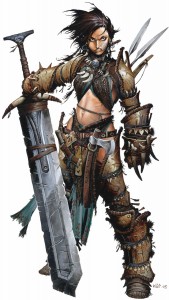 GenCon is less than two weeks away and we want to do our part to help make your con experience great. We’ve searched through the Dungeon’s Master archives to find articles that provide tips for players and DMs that are specifically related to conventions and public play. Of course these tips are often just as valid in your home games so even if you’re not going to GenCon we think you’ll find these tips applicable. You’ll likely see some trending throughout these articles because some tips are relevant regardless of context. In the end, we hope you find something in one of these articles that you can use to make your game and your con experience better.
GenCon is less than two weeks away and we want to do our part to help make your con experience great. We’ve searched through the Dungeon’s Master archives to find articles that provide tips for players and DMs that are specifically related to conventions and public play. Of course these tips are often just as valid in your home games so even if you’re not going to GenCon we think you’ll find these tips applicable. You’ll likely see some trending throughout these articles because some tips are relevant regardless of context. In the end, we hope you find something in one of these articles that you can use to make your game and your con experience better.
Tag: DM Resources
Month in Review: July 2012
It was another strong month here at Dungeon’s Master. We covered a wide variety of topics including sex and drugs in D&D, Wheaton’s Law, social media, essential RPG books and of course D&D Encounters. If you missed any of our articles from July than now is the time to get caught up. We’ve provided links below to everything we posted in July along with a brief description of each.
Our readership increased in July thanks to a couple of controversial articles and some amazing Star Wars pre-gens for D&D Encounters. We want to thank everyone who visited our site last month, especially those of you who comment regularly. Your feedback lets us know if we’re doing a good job and the overwhelming majority of comments are usually quite positive. Please keep reading and please keep providing your comments and questions.
Warning: This article discusses topics that are for mature readers. The ideas presented herein are intended to encourage a frank and mature discussion about adding darker, seedier topics to games with mature players. These ideas are being presented in the context of an imaginary, fantasy, role-playing game and are in no way intended to encourage, promote or glamourize them.
Sex, Drugs, Alcohol, Slavery. These are not the kind of things you generally think about including in a typical D&D game. After all, in a fantasy world why not preserve the fantasy and keep things idyllic? The only Evil (with a capital “E”) in most D&D campaigns are the monsters and NPCs bent on ruling or destroying the world. These are things the heroes can deal with, often at the end of a sword. Throwing more complicated Evils into a campaign setting, problems like substances abuse and slavery, for example, are not generally the kinds of things that can a) be handled by the PCs alone, or b) resolved in a single adventure. These are “big picture” problems that would just muddy the waters of most D&D campaign settings. Yet they are problems and issues that would certainly be present in most campaign settings. After all, these are problems that almost every society on Earth has faced and still does face in one way or another. So why not add them to your role-playing games and give the players a chance to try to do something about it?
Month in Review: June 2012
After a fantastic Canada Day long weekend we bring you the Month in Review for June (better late than never). Although June was one of the leanest months since we launched Dungeon’s Master we made up in quality what we lacked in quantity.
Our articles on minions, TPKs and Ameron’s D&D bucket list all generated discussion and got a lot of excellent comments. Our ongoing coverage of what some are calling the most deadly season of D&D Encounters since Dark Sun is also generating a lot of buzz. Throw in a D&D web comic and you get a pretty good idea of what we were up to in June.
We want to thank all of our readers for visiting Dungeon’s Master in June. We realize that a lot of people are play-testing D&D Next but we like to think that most of our articles are edition neutral and will still apply to your campaign regardless of what edition you play. So be sure to keep visiting and keep commenting.
If you missed any of the great articles from last month than this is your chance to get caught up.
A lot of DMs, me included, have run into the problem known as the 5-miute work day or the bed problem. This is when some or all PCs expend all of their resources more quickly than expected and demand an extended rest to recharge, regardless of what is happening in the story. We’ve run numerous articles on this topic and even offered a few ways to overcome it. (See The 5-Minute Work Day: Blame the Players and Solutions.)
Today we’re examining this problem from a slightly different angle. In my experience the best way to avoid the 5-minute work day is to put the PCs on the clock. Set up a situation where resting is simply not an option. Tie something in the story to a ticking clock and make it clear that the zero-hour event (whatever it may be) will happen well before 8 hours are up. So if the PCs try to take an extended rest it’s essentially game over.
This kind of adventure should only be undertaken on rare occasions. After all, very few PCs lives as exciting as Jack Bauer and will only find themselves working under this kind of exceptionally tight deadline in the most unusual and rare of circumstances. When DMs decide that it’s time to put the PCs into one of these situations you want to make it memorable. The encounters shouldn’t seem overly forced in order to work. With this in mind we present 5 Adventure Hooks below that will help you put the heroes in a fight against time as well as the usual hazards and monsters.
Minions: Full Disclosure
Is the DM obligated to tell the players that monsters are minions? I never do. Players don’t treat minions like they do other monsters. They don’t see them as threatening. And why should they, after all a minion only has 1 hit point and will fall with any hit that inflicts damage. In my mind the minion was one of the best additions to 4e D&D.
DMs can throw lots of monsters at the heroes, and as long as a bunch of them are minions then the PCs will just mow through them. They still have to target and hit them, but if a hit is scored the monster falls. There are, of course, some variations and exceptions to traditional minions – some minions explode when killed, some get a final attack and others still will rise from the dead to fight again after they’ve been killed once. Here at Dungeon’s Master we’ve introduced two-hit minions that, as the name implies, need to be hit twice to finally kill them. Regardless of what kind of minion you’re facing the commonality is that it doesn’t make a difference if you deal 1 point of damage or 100 points of damage with a single hit, you just have to hit them.
Minions are great and I encourage DMs to use them regularly, but DMs need to be careful how and when they reveal that some monsters are minions. As soon as player know that some for their opponents are minions they use this meta-knowledge to influence their PCs’ actions. For this reason I never disclose the fact that monsters are minions. I let the players discover this fact when their characters do. And if they make some poor assumptions I rarely correct them.
One of my biggest issues with D&D is the five-minute work day. This is when PCs expend all their best powers and burn through their healing surges so quickly that they’re useless unless they take an extended rest. The game is designed for PCs to have four or more encounters before they should need to take an extended rest but I suspect that many DMs rarely push through more than four encounters before calling it a day. However, there will be times when this just isn’t possible – either because it doesn’t make sense given how the story is progressing or the printed adventure doesn’t allow it. In these cases the DM may need to get creative to keep the PCs alive until the end of the day.
Assuming the PCs can still take short rests then output isn’t usually a big deal if the party continues on past four encounters. Sure they may not have those awesome daily powers at their disposal into the fifth encounter but they will have all their cool encounter powers. It’s healing surges that usually become the biggest problem.
Strikers generally have the fewest surges to begin with, and unless the player has a reasonable Constitution score or the Durability feat they’ll run out of surges quickly. What makes the problem worse is that as soon as monsters (intelligent monsters anyway) see a striker mowing through their ranks they’ll target the biggest threat (the striker). Unless you’ve got advantageous tactics or a decent defender at your side, strikers end up taking damage every fight.
So what’s a DM to do when this kind of thing happens? How do you keep a wounded party in the game and convince the players to push those PCs forward? It may just be a game, but players get emotionally attached to their PCs quickly and no one wants to enter a combat encounter knowing that their PC is likely to die. It’s a delicate situation that requires some careful manipulation. The key is not to do so in such a way that it insults the players or belittles the game mechanic. Players want to do well but they don’t want the DM to just give them an easy, unearned victory. It’s a real balancing act and here are 8 suggested ways to pull it off.
Month in Review: May 2012
May was a busy month at Dungeon’s Master. Despite our reduced publishing schedule we still showed great numbers and continue seeing upward trends. Running previews of the new D&D Encounters and Lair Assault certainly helped.
As the Dungeon’s Master home game moved into epic tier, so to does the focus of many of our articles. With the inevitable launch of D&D Next in the not-too-distant-future many of us are trying to get some epic play in before we shift to the new edition. With very few other blogs writing about playing in the epic tier we are becoming the place to visit for high level inspiration. Please let us know if there are any aspects of epic adventuring that you’d like us to focus on.
A lot of the gaming blogs are writing about D&D Next. Although we are participating in the play-testing we have decided to keep our comments and feedback on the new D&D to a minimum for now. We developed our core audience by being the place to go for 4e materials online. We intend to keep that audience happy by focusing on 4e and proving fresh new material for ongoing 4e campaigns. Many of our articles are edition-neutral and can easily be applied to whatever version of D&D you’re playing, including D&D Next, so if you’re fully engrossed in D&D Next we’re confident that you’ll still find many or our articles helpful. However, in the short-term we are staying true to our roots and focusing the majority of our effort on writing about 4e.
We’d like to thank everyone for visiting Dungeon’s Master in May. We saw a lot of new people commenting last month and we hope they continue to share their thoughts and feedback. We value your opinion and want to hear what you have to say. Remember that you can always email us (our email addresses are on the about page) if you have any questions or have an idea for an article.
When an adventurer begins his career he’s always looking for magical treasure. Even in a magic-rich setting a +1 sword is a coveted item. As the character advances he will seek more items with even higher plusses. After all why stick with a +1 sword when you can have a +2 sword? But eventually the plus no longer matters. Believe it or not there comes a time when the player realizes that the plus isn’t the most important part of a magic item. Eventually an item’s power or ability is deemed more integral to the character than one more plus.
Our home campaign recently moved into the epic tier. During a recent adventure the heroes completed a major story arc and were rewarded with treasure suitable to their level as well as a level 30, +6 bow. Although two characters in the party use bows and both currently have +4 bows neither player was interested in the item. They were content to keep their level 17 and 18 weapons respectively than trade up for a level 30 magic item. These are players that are among the greediest I’ve ever played with (and I mean that as a compliment) yet they both felt that it severed their character better to keep their current +4 bows than trade up for a +6 replacement. In both cases it was because of the importance of the power their current weapons gave them.
 You’re never too old to learn something new. Adventurers need to remember this. No matter how powerful they become there’s always someone who’s more powerful, or more skilled than they are.
You’re never too old to learn something new. Adventurers need to remember this. No matter how powerful they become there’s always someone who’s more powerful, or more skilled than they are.
In Adventure Hooks: The Legendary Sword Masters (Part 1) we suggested that at some point in your campaign the heroes may need to learn a special fighting technique from a legendary sword master. When such circumstances arise they’ll first need to find the legendary master and then convince him to train them. As he’ll likely become and integral part of the story arc, it’s important that he be interesting and memorable. Today we provide six more examples of legendary sword masters that you can use in your campaign.
It’s important to note that although we use male pronouns and refer to the PCs as masculine, the example masters listed below will certainly work if they are portrayed as female. Just look at the picture at the top of this article. She clearly looks like she can handle that massive blade like a pro. Many gamers (including the majority of the ones I play with) will hear “sword master” and assume it’s a man they’re looking for. Making the legendary sword master a woman can add an interesting aspect to the role-playing.
Regardless of the master’s sex, the character needs to be well developed and have a distinct personality. We’ve provided enough details to get you started but DMs should feel free to tweak these masters as they see fit. With the exception of the Dwarven Master none of them specify race so it’s entirely possible that they could be a race the PCs least suspect. Throwing conventional wisdom and preconceptions out the window is a good way to make any NPC more interesting.
